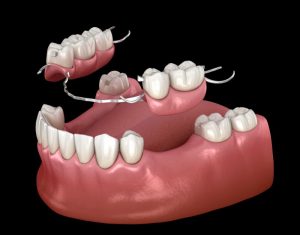
Dental technology has come so far in just a few decades. These days, more and more people are retaining their natural teeth for much longer than they used to. However, tooth loss is still a common issue. If you’re looking for a way to replace multiple missing teeth, you’ve probably heard about dental bridges or partial dentures. While these options share many similarities, they each have their own unique characteristics. Read on to discover the difference between partial dentures and dental bridges – and how to find out which solution is right for you!
What Are Dental Bridges?
A dental bridge is a simple, convenient way to replace one or more missing teeth in a row. This restoration – custom-made based on impressions that your dentist takes of your mouth – consists of several dental crowns that are strung together. The crowns on either end of the prosthetic are placed over the natural teeth at each end of the empty space in your grin. In some cases, a bridge can be secured onto dental implants that are placed in your jawbone instead of remaining teeth. Either way, bridges can usually only be removed by a dentist.
On average, you can expect a traditional bridge to last for about 10 years before it has to be replaced. However, it may last for much longer if you take good care of it with daily oral hygiene and regular dental checkups.
What Are Partial Dentures?
A partial denture is often used to replace several missing teeth that are not consecutive. They are designed to fill the gap between your remaining teeth like the last piece of a jigsaw puzzle. The artificial teeth are attached to a gum-colored base and a metal framework that is secured into place behind your real teeth. Like bridges, partials can be fastened onto dental implants. Most partials are removable for easy cleaning.
Generally, partials last somewhere between five and 10 years before needing a new one. Older patients typically require more frequent replacements because of bone loss in the jaw.
Which Solution Is Right for Me?
Ultimately, you’ll need to see your dentist for a consultation to find out the answer. They’ll evaluate your dental health, as your remaining teeth must be healthy to support either prosthetic. Based on their findings, they’ll draw up a personalized treatment plan to complete your smile. More often than not, dentists will recommend a dental bridge for consecutive missing teeth and a partial for several missing teeth throughout an arch.
Either way, you won’t have to live with the challenges of tooth loss forever. Your dentist will create a tooth replacement that restore the natural appearance and function of your smile. Schedule a consultation today to learn more!
About the Author
Dr. Barry R. Franzen is a highly skilled prosthodontist in Milwaukee, WI with 30+ years of experience. His extensive training in dental implants has led to his achieving a Fellowship of the International Congress of Oral Implantologists. Throughout his career, he has focused on esthetic replacement teeth, including bridges and partial dentures. If you’d like some guidance on choosing between partial dentures and dental bridges, you can contact Dr. Franzen’s office at (414) 543-5432.
